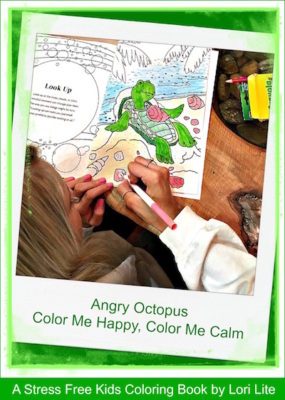
by Lori Lite
We’ve probably all witnessed how quickly kids calm down coloring no matter how active they were just a few moments ago. When we sit down at a restaurant, our children cheer up the moment the server places a coloring sheet and crayons in front of them. Instantly, we see our kids quiet down and relax as they start to put all their focus on selecting the right color and picking the best spot to get started.
But what is it about a few crayons and a coloring sheet that makes kids calm down coloring?
Coloring can reduce anxiety. The back and forth rhythm of the crayon on paper is soothing. “Coloring definitely has therapeutic potential to reduce anxiety, create focus or bring {about} more mindfulness.” Says Marygrace Berberian, a Certified Art Therapist and Program Coordinator for the Graduate Art Therapy Program at NYU.
Coloring leads kids to focus. Because children want to complete the coloring page to the best of their abilities, they zone out everything else around them. But because it isn’t quite like the pressure that they often feel at school or doing a chore, they respond to the demand to focus entirely, feeling no tension.
Coloring reduces anger. This is especially true when children color Angry Octopus Color Me Happy, Color Me Calm. Each page introduces a technique or activity that motivates children to express themselves peacefully without having a tantrum, meltdown, or outburst.
Coloring requires hand-eye coordination. The simple act of holding a crayon and coloring within the lines is an act that demands their physical concentration as they strengthen their fine motor skills. (Of course in keeping coloring stress free, coloring outside of the lines is also encouraged.)
Color affects the brain, mood, and emotions. Some colors evoke a relaxation response while others motivate. A child can go from sad to glad within minutes of coloring by choosing mood changing happy colors. One study explored changing the colors on the walls of a classroom. Teachers reported that the children’s behavior improved. The students were more attentive and less fidgety.
Coloring is a mindful practice. We keep hearing that we can reduce stress by practicing mindfulness. Mindfulness can help “re-wire your brain,” says Melanie Greenberg, PhD, a clinical psychologist. Coloring is one of the easiest ways for children to experience this intangible concept of being mindful. Adults too!
Coloring mimics meditation. One of the greatest challenges novice meditators face is to stop the brain chatter. Dr. Rodski, a neuropsychologist, told Medical Daily that coloring elicits a relaxing mindset, similar to what you would achieve through meditation. This is easily achieved while coloring.
Coloring is calming. Using advanced technology, Dr. Rodski was able to see the physical effects that coloring has on the body. He told the Australian Broadcasting Corporation that “the most amazing things occurred — we started seeing changes in heart rate, changes in brainwaves.” These neurological responses came from the repetition and concentration to patterns and detail associated with coloring.
Coloring increases joy. The act of coloring has the power to replace negative feelings with positivity. Because coloring is such a joyful activity, there’s little room to entertain fear based or negative thoughts. Kids calm down coloring almost instantly, freeing themselves with joyful thoughts and a sense of accomplishment. Their self-esteem gets a boost.
Coloring, while meant to be a fun activity also has incredible therapeutic effects. Coloring empowers children to think creatively, to be themselves, and experience a screen-free unplugged activity. Ultimately, kids calm down coloring because while the fun demands concentration, coordination, decision-making, and mindfulness, the act itself is not at all demanding.
Angry Octopus Color Me Happy, Color Me Calm is also available in bulk orders at discounted prices for the entire classroom.
Lori Lite is a mom, founder of Stress Free Kids, and author. After helping her own children, Lori understood that her mission was to help other parents and children struggling with stress, anger, and self-esteem. Her award-winning titles are considered a resource for parents, psychologists, therapists, child life specialists, and teachers. Lori’s constant upbeat presence on social media has been awarded numerous accolades to include Top 100 Parenting Experts to follow on Twitter. Her sought after practical tips have been featured in hundreds of media outlets, including CBS News, CNN Living, WebMD, and Family Circle magazine.